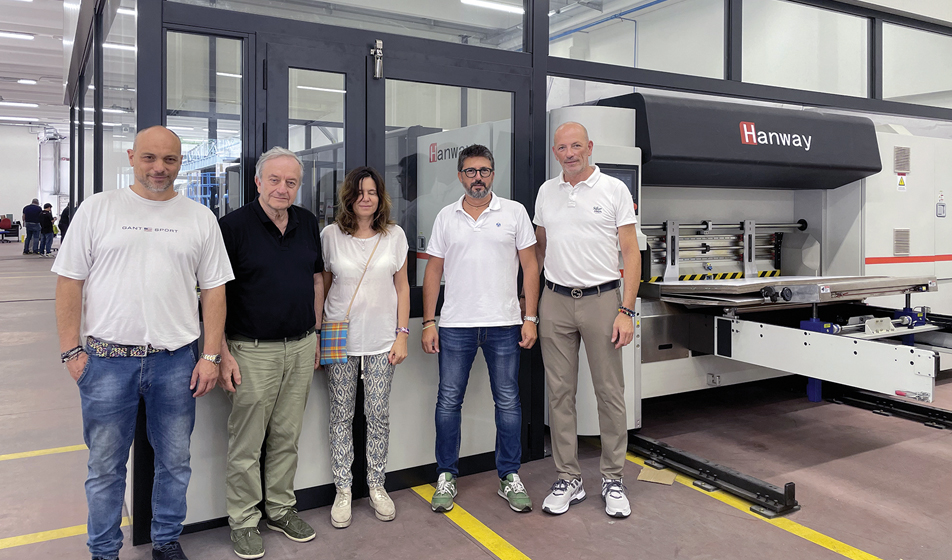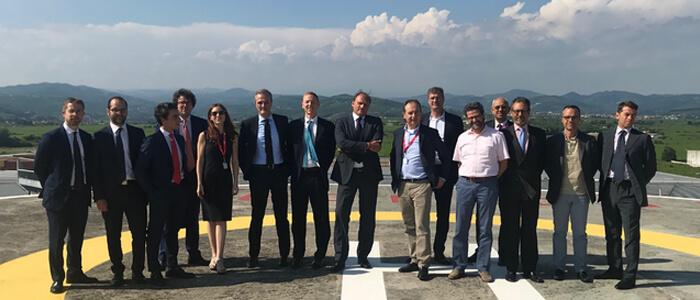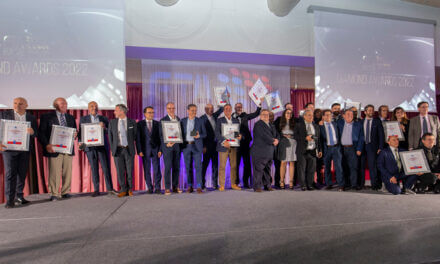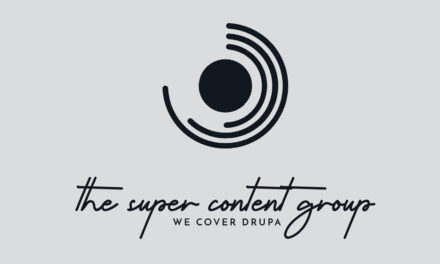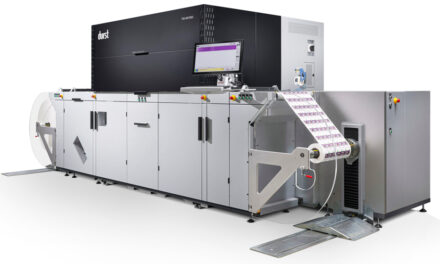In Italy, the first European installation of Hanway’s industrial post-print system for single-pass inkjet printing on corrugated board.
by Alexia Rizzi
Between the Como textile district and the Brianza area of furniture and interior design, precisely in the industrial area of Senna Comasco (CO), lies another Italian excellence that has been producing corrugated cardboard, boxes and packaging for fifty years: Zetacarton, where ‘zeta’ stands for the first letter of the surname of its founders Angelo Zanfrini and his sons Giovanni, Giuseppe and Cesare. Founded in 1974, it has quickly become a reference point for its sector in the area. Actually, the idea of the carton business comes from further back, when in the 1950s Angelo and Maria Zanfrini started a small printing business, which they later joined with the production of folding carton and corrugated boxes. The story of Zetacarton’s origins is one of dedication, expertise and passion but also of pioneering impulses that have led it to its current success and today’s decision to project itself into the digital age in collaboration with Hanway and Errelle (Hanway Italia).
A leader who keeps making plans
Led by Giuseppe Zanfrini, president of the board of directors, and Serena Zanfrini, CEO – who represents the third generation in the company – today Zetacarton is the market leader in Italy, with a turnover in 2022 of around 78 million euros and the annual production of 110,000,000 square metres of corrugated cardboard, both in sheets and endless forms. To give an idea of the proportions, this is 1.22% of national volumes: considering that Italy is the second largest producer in Europe this is a remarkable achievement. The company, which operates in a modern 30,000 square metres plant on a total surface area of 60,000 square metres and employs 110 people, has always made strategic investments in both the cardboard production department and the flexo and offset printing presses, anticipating the times and at times choosing alternative routes compared to its competitors.
“This is the future!” is how Giuseppe Zanfrini greets us as he shows us the Hanway Glory1606 installed in a dedicated area of the Zetacarton production site. The machine, which has been operational from June 2023, is printing at full capacity as we visit the company and the satisfaction of the people around is immediately noticeable. We see an operator taking a sheet from the output stack and examining it together with colleagues and technicians from Hanway and Hanway Italy: “This is it: perfect,” he says.
Digital production flow
We ask Giuseppe Zanfrini to comment on this technology: “we are very satisfied,” he replies. “We wanted to diversify production by introducing digital technology to expand our product offering and migrate some jobs from traditional to digital printing. After considering other solutions, we chose Hanway Glory. We are confident that the new machine will live up to our expectations in the future”.
The word future associated with Glory 1606 comes up several times in the conversation: there is a precise business plan surrounding this investment, that envisages the development of a full-cycle automated digital production line over the next two years. Explaining in detail how the project will come to fruition is Filippo Bombardieri, the company’s technical sales manager. We walk with him along the more than 5-metre length of the machine: “upstream of the feeder we will install an automatic feeder that we are studying ad hoc,” he explains, as he proceeds to show us the air conditioning cabin. Built around the infrared printing and drying unit to allow temperature and humidity control, its purpose is to maintain maximum printhead efficiency and carton sheet stability.
Having passed the coating unit – a unique plus on this machine category that avoids the need for protective plasticisation of the carton – we move on to the stacker. But the journey is not over yet: “From this part there will be a connection to the adjacent hall to join the press to the finishing department where pile turners, cutting plotters, die-cutters and, finally, a cardboard packaging line will be installed,” continues Bombardieri.
Why Glory?
“The quality, the versatility of the system and the TCO analysis, which we conducted based on the transparent data provided by the manufacturer, are what convinced us to invest in the Hanway Glory 1606,” says Giuseppe Zanfrini. 6-colour single pass inkjet technology (CMYK+LC and LM) – even if the configuration chosen by Zetacarton stops at four-colour – Kyocera print heads, water-based inks compatible with food contact, Caldera RIP: these are the features of this industrial system, compatible with the different types of corrugated cardboard (white, kraft and coated) and capable of reaching printing speeds of up to 180 metres/minute.
“Respect for the environment is also a crucial aspect: the use of water-based inks that are not harmful to the environment goes perfectly well with cardboard, a recyclable material that can be produced with a percentage of recycled fibre, are all elements in line with our ESG-oriented development strategies,” specifies Serena Zanfrini, who informs us that she is currently finishing the drafting of the company’s Sustainability Report with her team.
The arrival of Glory was also well received by the operators: four employees from Zetacarton’s printing department were enthusiastic about switching to the digital division and becoming an active part of this important project. A new prepress operator is also part of the digital team.
A win-win partnership
Also determining the partnership between Zetacarton and Hanway was a particular affinity of values and operating methods between these two companies, which emerged from the first meeting with Errelle’s sales force. “As Hanway Italia, we had planned to install the Glory 1606 in our Turin showroom,” explains Luca Pallo CTO and founder of Errelle. “But when we presented some samples printed with this technology to the Zetacarton management, the decision to invest in this system was taken so quickly that we destined the machine to be shipped directly to the Senna Comasco production site.”
What convinced the customer was not only the machine’s performance but also Hanway’s great flexibility in accommodating some of its customisation requests. At Zetacarton’s request, the Glory 1606’s printable paper size of 160x280cm was increased to a length of 405cm to allow the production of packaging for furniture and pallet wrapping. Another change concerned the minimum substrate thickness from 1.5mm to 1.3mm. Conversely, Zetacarton has agreed to act as a European beta site and is open to companies interested in viewing the machine and carrying out print trials. “It is a momentous challenge,” concludes Luca Pallo. “Our engineers, those at Hanway and the team at Zetacarton are working together to get a project off the ground that will pave the way for single-pass inkjet technology for corrugated board in Europe.

